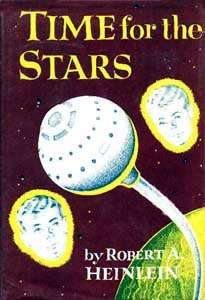Torchship
Torchship (or torch ship) is a term used by Robert A. Heinlein in several of his science fiction novels and short stories to describe fictional rocket ships that can maintain high accelerations indefinitely, thus approaching the speed of light. The term has subsequently been used by other authors to describe similar kinds of fictional spaceships.
Heinlein's use of the term

In his 1950 novel Farmer in the Sky, Heinlein describes a "mass-conversion ship" that derives its motive power from the complete conversion of mass to energy. The narrator of the novel, who is traveling to Jupiter in a mass-conversion ship called the Mayflower, describes it as follows:
The Mayflower was shaped like a ball with a cone on one side — top-shaped. The point of the cone was her jet — although Chief Engineer Ortega, who showed us around, called it her "torch".
Later in the novel, Ortega is quoted as saying:
"The latest development is the mass-conversion ship, such as the Mayflower, and it may be the final development — a mass-conversion ship is theoretically capable of approaching the speed of light."
The scientific advance that permits this efficient conversion of mass to energy is called the "Kilgore equations" (likely a reference to Kilgore Trout).
In later novels and stories, including "Sky Lift" (1953), Time for the Stars (1956), and Double Star (1957), Heinlein refers to mass-conversion ships as "torchships" and to their pilots as "torchship pilots." Exposition in Tunnel in the Sky (1955), states "Ortega's torch ships could reach the stars," but explains the need for Gates to move surplus population off-planet, as it would be impossible to build/crew enough ships to carry a significant fraction of the human race. In Have Space Suit - Will Travel (1958), the protagonists are kidnapped by hostile aliens and taken to Pluto aboard a space ship that accelerates at more than one gravity for days at a time, although the ship is never explicitly referred to as a "torchship".
The "torch" is said to work with any matter as fuel; in Time for the Stars, the ship refuels by landing in water, or in one case liquid ammonia.
Use of the term by other authors
The term "torchship" was adopted by a number of other science fiction authors, including
- Norman Spinrad in Riding the Torch (1975)
- Dan Simmons in Hyperion Cantos (1983-1999)
- David Brin and Gregory Benford in Heart of the Comet (1986)
- Pierce Brown in his trilogy "Red Rising" (2014-2016)
- Ben Bova and his Grand Saga.